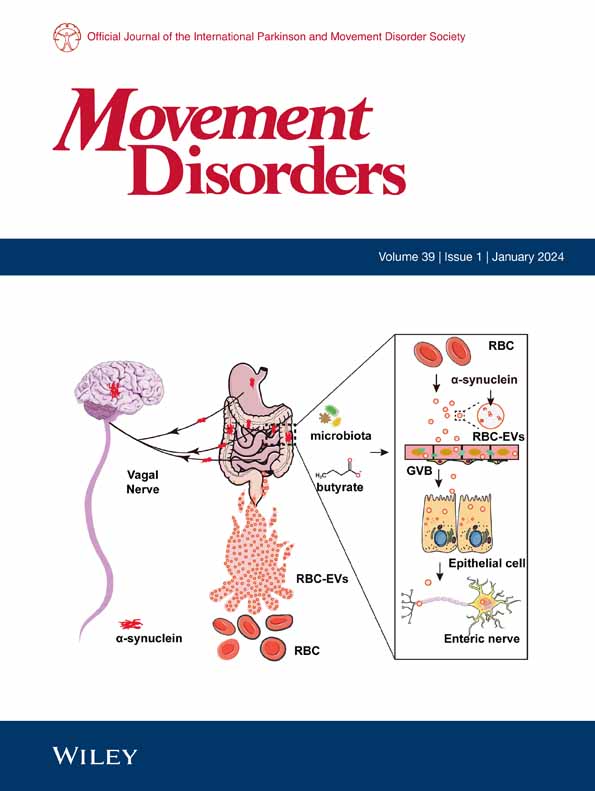Neuronally‐Derived Extracellular Vesicles Transforming Growth Factor Beta‐1 Levels in Progressive Supranuclear Palsy
IF 7.4
1区 医学
Q1 CLINICAL NEUROLOGY
引用次数: 0
Abstract
BackgroundDifferentiating progressive supranuclear palsy (PSP) from other parkinsonian disorders may be challenging.ObjectivesTo investigate the role of transforming growth factor beta‐1 (TGFβ1) in PSP.MethodsA total of 33 PSP, 39 Parkinson's disease (PD), 8 multiple system atrophy (MSA) patients, and 50 healthy controls (HC) were enrolled. TGFβ1 levels, including both active and inactive forms (latency‐associated peptide [LAP]‐TGFβ1), were measured in serum, total extracellular vesicles (EVs), and neuronally‐derived EVs (NDEVs) using microfluidic assays and ELISA.ResultsPSP patients exhibited a marked increase in TGFβ1 and LAP‐TGFβ1 levels in NDEVs, while no differences were observed across groups in serum or total EVs. Receiver operating characteristic (ROC) analysis demonstrated outstanding performance in differentiating PSP from non‐PSP patients (TGFβ1, area under the curve [AUC]: 0.97; LAP‐TGFβ1, AUC: 1.00), HC, AUC: 1.00).ConclusionsThis study highlights TGFβ1 and LAP‐TGFβ1 in NDEVs as promising blood‐based non‐invasive biomarkers for PSP diagnosis, paving the way for further research on these proteins in PSP. © 2025 The Author(s).进行性核上性麻痹中神经元来源的细胞外囊泡转化生长因子β - 1的水平
背景:将进行性核上性麻痹(PSP)与其他帕金森病鉴别可能具有挑战性。目的探讨转化生长因子β - 1 (tgf - β1)在PSP发病中的作用。方法共纳入PSP患者33例,帕金森病(PD)患者39例,多系统萎缩(MSA)患者8例,健康对照(HC)患者50例。采用微流控法和ELISA检测血清、总细胞外囊泡(EVs)和神经源性EVs (NDEVs)中的tgf - β1水平,包括活性和非活性形式(潜伏期相关肽[LAP]‐tgf - β1)。结果spsp患者在NDEVs中tgf - β1和LAP - tgf - β1水平显著升高,而血清和总EVs在各组间无差异。受试者工作特征(ROC)分析显示,在区分PSP与非PSP患者方面表现出色(TGFβ1,曲线下面积[AUC]: 0.97;Lap‐tgfβ1, auc: 1.00), hc, auc: 1.00)。结论本研究突出了NDEVs中tgf - β1和LAP - tgf - β1作为有前途的基于血液的非侵入性PSP诊断生物标志物,为进一步研究这些蛋白在PSP中的作用铺平了道路。©2025作者。Wiley期刊有限责任公司代表国际帕金森和运动障碍学会出版的《运动障碍》。
本文章由计算机程序翻译,如有差异,请以英文原文为准。
求助全文
约1分钟内获得全文
求助全文
来源期刊

Movement Disorders
医学-临床神经学
CiteScore
13.30
自引率
8.10%
发文量
371
审稿时长
12 months
期刊介绍:
Movement Disorders publishes a variety of content types including Reviews, Viewpoints, Full Length Articles, Historical Reports, Brief Reports, and Letters. The journal considers original manuscripts on topics related to the diagnosis, therapeutics, pharmacology, biochemistry, physiology, etiology, genetics, and epidemiology of movement disorders. Appropriate topics include Parkinsonism, Chorea, Tremors, Dystonia, Myoclonus, Tics, Tardive Dyskinesia, Spasticity, and Ataxia.
 求助内容:
求助内容: 应助结果提醒方式:
应助结果提醒方式:


